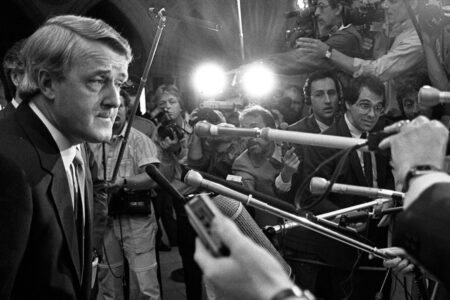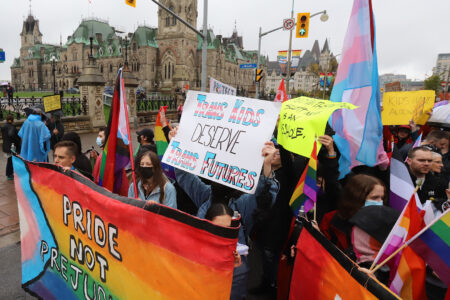
As we approach the election of a new leader of the Conservative Party of Canada this weekend, this is an opportune moment to examine the health of the policy-making process in the conservative movement in Canada. After all, the modern-day Conservative Party has had no other leader than Stephen Harper, and its platforms and policies have to a large degree reflected his priorities — as informed by party members, the Conservative caucus, and the realities of governing. A new leader and would-be prime minister will need to establish his or her own direction and credibility, in part by developing policy responses to new and changing conditions in Canada and globally.
One advantage of the lengthy leadership campaign is that it has given the candidates time to develop and present their policies to party members. A few have taken advantage of the opportunity, but most have outlined comprehensive platforms that address a range of policy concerns.
The purported frontrunner, Maxime Bernier, has run what he has called a “campaign of ideas,” centred around greater personal and market freedoms and the idea of a more limited government. The former cabinet minister has attracted attention with his proposals to eliminate all corporate subsidies and to end supply management.
Erin O’Toole has presented a particularly detailed and thorough 50-page outline of his vision for Canada, with proposals like Generation Kickstart, which would give students a $100,000-$200,000 basic personal tax exemption over the first few years after they graduate. Former Speaker of the House Andrew Scheer has proposed to remove taxes on home energy costs and ensure free speech on university campuses. Kellie Leitch famously has promised to submit all would-be refugees and immigrants to an in-person interview to make sure they subscribe to “Canadian values.” Lisa Raitt has outlined national strategies to address autism and dementia. Michael Chong has proposed to double the Working Income Tax Benefit to assist low-income Canadians.
There has been no shortage, then, of policy ideas or debate during the leadership race. The problem — if we can call it that — is that many of the candidates’ platforms represent relatively minor variations on the Harper agenda: lower taxes for individuals and businesses; direct support for families, seniors and veterans; investment in infrastructure; expanded free trade; reorientation of the immigration system toward economic needs; concrete measures to fight crime and terrorism; careful management of government finances; respect for provincial jurisdiction; and principled stances in support of our global allies.
Very little new thinking in the party is on offer around challenges such as the impact of automation on workers, the use (and misuse) of big data, regulation of new business models, the mismatch between skills training and available jobs, social program sustainability in the context of an aging population, who Canada should be trading with if the US is unreliable and China is untrustworthy, and how best to support innovation and economic diversification. Similarly, apart from Erin O’Toole’s platform, there has been little substantive discussion of issues that Conservatives have not traditionally campaigned on, but that must be addressed by any prime minister in waiting, such as the toxic relationship between government and Indigenous people, and balancing economic development with preservation of the environment (Michael Chong’s luckless carbon tax proposal aside). And, there has certainly been no real discussion of “third rail” topics like health care (again, except by O’Toole), employment insurance and pension reform.
With few exceptions, then, the candidates have taken a cautious approach to policy development, one that stays within the boundaries established during the Harper era. Only Bernier has tried to break out of the box to any significant degree, and the problem with many of his proposals is that they are unworkable from a fiscal perspective. Bernier’s commitment to balance the budget within two years will require major reductions in federal spending, given the deficit-oriented direction set by the current government. It will simply not be possible for him to fulfill his other eye-wateringly expensive promises, including eliminating the capital gains tax, reducing the corporate tax rate from 15 percent to 10 percent, implementing a two-tier personal income tax system, and raising the basic personal exemption amount. In fact if, as expected, Bernier is the successful candidate on Saturday, one of his biggest challenges will be to rescope his platform so that it meshes with fiscal reality and can also meet his supporters’ considerable expectations.
The policy proposals on offer. . .do not respond to voters’ expectations that a government-in-waiting is anticipating and developing responses to current and upcoming policy challenges.
To be clear, there is nothing wrong with the candidates’ focus on lowering taxes, balancing the budget, developing our resources responsibly, or keeping Canadians safe. The policy proposals on offer cover a waterfront large enough to attract a significant constituency of electoral support and to govern the country well and credibly. But they do not represent the full scale of policy challenges that any future leader of this country will face, and they do not respond to voters’ expectations that a government-in-waiting is anticipating and developing responses to current and upcoming policy challenges.
There are a number of reasons for the too-conservative approach to Conservative policy-making.
The nature of leadership races
During leadership contests, candidates focus on appealing to a core group of committed party members who want to be reassured that a new leader will address certain issues of particular importance to them. For Conservative candidates, that means, among other things, assurances that tax rates will not be raised to fund government programs of dubious value, that the rights of criminals will not override those of victims, that Canada’s security will not be compromised, that the needs and priorities of rural and northern communities will not be ignored, and that we will stand with our allies on the international stage. In that sense, during a leadership race, the candidates are reaffirming their conservative bona fides rather than presenting a comprehensive agenda for governing.
Policy-making from the bottom up
The Conservative party has historically been more “bottom up” than “top down” in terms of policy development. Any party member can, through his or her electoral district association, bring forward a policy proposal that may ultimately be voted on at the party’s national policy convention. Overall this grassroots approach to policy-making is a good thing, because it means the party is responding to the concerns of its members and supporters and is not becoming detached from members’ priorities, in opposition or in government. The Liberal Party, on the other hand, tends to impose policy direction from the top down through a small, hand-picked elite, which is partly why it has more difficulty raising money from individual members.
The Conservative nature
Conservatives are, by nature, conservative, and properly suspicious of so-called “big ideas.” For many conservatives, “big ideas” is code for bigger government and higher taxes to support bigger government. However, apart from a few recalcitrant public policy problems and daily irritations, major and minor, our country generally works well as it is. It is, for good reason, the envy of the developed world. As a mature and healthy democracy that is functioning well, Canada has reached the stage where an incremental approach to policy-making is appropriate. That means tweaking existing programs rather than embarking on wholesale change, particularly when government budgets are already under pressure to fund existing entitlements. In other words, we should be improving what we have in place already, rather than starting anew. Therefore, any political desire for a policy “legacy,” or media desire for something new and exciting to write about, should rightly be regarded with alarm. For many Conservatives, the best legacy is good and competent government that serves citizens well and maintains Canada’s enviable standing internationally.
An absence of policy-making organizations
In the conservative movement in Canada, unlike that in the US, there are no specific bodies or organizations devoted to thinking about public policy challenges and developing explicitly conservative responses to them. There are some market-oriented think tanks that produce good work on (mostly) fiscal issues, but they are not agile or responsive enough to be truly useful resources. Other conservative policy voices are few and far between, and there is no process for funnelling their ideas to the members for consideration and debate. Members are not well placed to identify upcoming public policy issues and, in any event, it is unrealistic to expect them to generate options in response to complex policy challenges. The Conservatives are unique in this respect — the NDP engages in policy development through the coordinating efforts of the Broadbent Institute, and the Liberals’ connections with the academic and business elite have resulted in an abundance of partisan Liberal think tanks and policy nodes. The Manning Centre in Calgary is well-positioned to take on a policy coordination and oversight role on behalf of the conservative movement, but so far it has chosen not to. Its most recent conference, though well-attended by conservatives across the spectrum, was notably thin on substantive policy discussion.
I do not subscribe to the notion, which some commentators have put forward, that there is a “right” conservative ideology or policy approach — one, for example, that is entirely market-oriented, or rejects populist anxieties as ill-informed and unfounded. Approaches, and even certain principles, must be vigorous debated in the light of economic and electoral realities. Free trade is not an unvarnished good, nor is unrestrained free-market capitalism, nor even are significantly lower tax rates, without due consideration of the competitive landscapes and the services needed.
Similarly, consumer-oriented measures to restrict abusive behaviour by corporations with particular market power should not be anathema to conservatives. That does not mean principles should be matter of political convenience, to be abandoned at the slightest hint of resistance, but it does mean avoiding slavish adherence to ideology, in favour of constantly questioned positions and common-sense solutions.
The gap in conservative policy development capacity does a particular disservice to Conservative Party leadership candidates and the soon-to-be-elected leader, since he or she will need robust and relevant policy advice to be successful in 2019. As former Harper adviser and academic Sean Speer recently pointed out, it is not the role of the Conservative Party itself to engage in policy work. Political parties should be focused on what they are primarily designed to do, which is to fight and win elections. And, from experience, I know that a leader cannot rely on the policy-making capacity within the civil service alone, once he or she has been elected to government; the Trudeau administration’s reliance on external advisory bodies provides ample additional evidence of that.
What the conservative movement in Canada needs now is an organized, consistent, relevant policy voice that can engage in policy debate and coordinate well researched and well argued conservative policy solutions, for the benefit of party members and of Canadians more broadly. Without that kind of policy resource, conservative candidates for office will largely continue to offer variations on the Harper agenda, which provided good and appropriate policies during the Harper years but will not, on their own, be sufficient to provide a truly credible alternative to the Trudeau government.
Photo: Conservative leadership candidates shake hands following the Conservative Party of Canada leadership debate in Toronto on Wednesday April 26, 2017. THE CANADIAN PRESS/Nathan Denette
Do you have something to say about the article you just read? Be part of the Policy Options discussion, and send in your own submission. Here is a link on how to do it. | Souhaitez-vous réagir à cet article ? Joignez-vous aux débats d’Options politiques et soumettez-nous votre texte en suivant ces directives.






